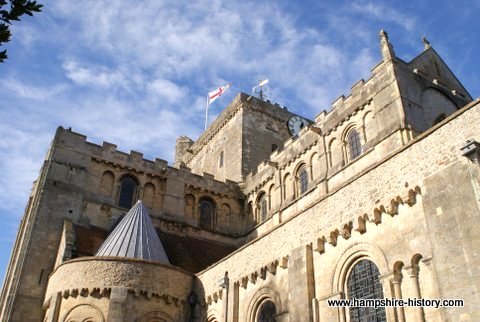Hampshire, along with Berkshire and Wiltshire were the core of King Alfred’s West Saxon kingdom which emerged triumphant after the devastating Viking raids which unleashed their terror on England
When the Viking raids took place on the coasts of Hampshire, they sought to strike terror into the local communities. They sacked and burnt property, including the new fledgling Christian churches. Despite this, the impact of the Vikings on churches in Wessex seems to be relatively slight in comparison to that seen elsewhere in Southern England and some parts of Hampshire suffered more than others. Southampton was severely diminished by the attacks, whereas Winchester was able to defend itself better. 
The Massive Viking boats pushed up the sheltered estuaries of the southern coast and allowed the Vikings to infiltrate quickly to the heart of Wessex
The first Viking attacks found little resistance, in Wessex. The Anglo Saxons were unable to gather together a cohesive army to defend themselves. Shortly after the first Viking attack in the C8th, the kingdom of Wessex was founded under Egbert the Saxon, he sought to unite the large kingdoms of Mercia and Anglia under the headship of the Western Saxons. Even so, Southampton, which was a major trading centre prior to the Viking raids, was largely abandoned in the C9th in the face of Viking attacks. Winchester, a town largely ignored when the Romans left, was now re-emerging as atown with royal patronage and thus it was fortified and protected from the worst the Vikings could throw at it.
The destruction of the churches, where it occurred, of course had an immediate effect upon the people but it also gave rise to another consequence. Wessex, prior to the Viking attacks, was making progress towards closer ties with Charlemagne and the Franks. All efforts now had to be switched towards fighting and defending against the attacks. There was little time or energy left to restore the churches and that cultural links being fostered with Europe. The church symbolised that culture, the architecture, writing and art that came with Christianity was all but swept away.
How did the minster churches survive?
The second Viking wave of attacks in the C9th met the full force of King Alfred but not before they had subjected the people of Wessex to more voracious attacks and one presumes sacked many of the Saxon churches. However the great minster churches at Titchfield, Winchester and Romsey appear to have been left unscathed by the groups of Vikings as they made their way up the river valleys of Hampshire. Given the wealth of Winchester Minster and the monasteries, it might have been possible that the Viking raiders were paid large sums of money to leave the Minsters alone.With the Viking’s defeat by King Alfred and their leader, Guthrum’s conversion to Christianity, a period of peace prevailed in Wessex. King Alfred was keen to create order where there had been mayhem and part of that programme would have been the re-building of churches. More stablisation followed with coins being minted to further trade and literacy being encouraged. Within this more stable environment, the church began to flourish and income from produce on landholdings perhaps began to be equally prized as that raised from war.
King Cnut and Hampshire churches
All was not plain sailing though and they were offered little protection from attacks by King Sweyn and King Cnut. But during the period of King Cnut’s reign, another period of church building took place, this time replacing wooden churches with stone and a few structures remain in our Hampshire churches as evidence of this early church building, such as at Headbourne Worthy and Corhampton. The New Minster Liber Vitae, which is on display in the Viking Exhibition at the British Museum, shows Cnut and his wife Queen Emma, presenting a cross to the altar of New Minster, Winchester.  Having recovered itself, Hampshire had only a short spell of stability before the next wave of invaders, this time the Normans (Vikings under another guise), fell upon its settlements destroyed them and then taxed them heavily. The delicate church structures the Saxons had built were swept away, as King William I imposed their fortress like architecture onto the cathedrals, abbeys and churches.
Having recovered itself, Hampshire had only a short spell of stability before the next wave of invaders, this time the Normans (Vikings under another guise), fell upon its settlements destroyed them and then taxed them heavily. The delicate church structures the Saxons had built were swept away, as King William I imposed their fortress like architecture onto the cathedrals, abbeys and churches.



